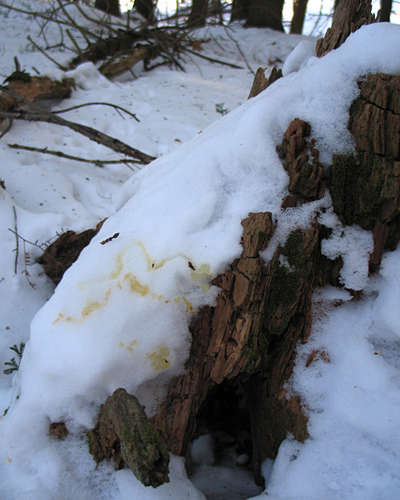The life of the river: pee stains or what are you trying to tell me?
Note: This page is outdated and may have formatting errors. If you want to share the URL, please email communications@fmr.org, and we will update this page to our current standards.

Red fox scent mark
Animals, especially mammals, have interesting ways of communicating with each other. I will leave the sophisticated, intricate and often odd Homo sapiens communication to others and instead focus on some of our lesser fellow passengers. Now, there are a gazillion directions we can go in when discussing mammal communication. The one that I currently find interesting and that you can go out and view yourself in the wonderful winter wonderland is scent marking.
First, some basics. The Oxford Dictionary defines scent marking as an odoriferous substance containing a pheromone deposited by a mammal from a scent gland or in the urine or feces, typically on prominent objects in an area. Scent marking is essentially chemical communication. Dogs, wolves, bears, bobcats, deer, and mice all do it. Humans, as a rule, do not. Individuals remember scent mark locations and visit frequently to get the latest news. These scent marks not only provide information about the territory you are currently entering but also about the health and condition of the animal depositing the smell, which is helpful for females looking for a mate. Scent marks are also used for marking trails, as alarm signals and for announcing one's social status.
Otters leave stained or fecal deposits as scent marks. In addition to the above information, researchers think these spraints are deposited during the commencement of feeding, providing information that someone, in this case, an otter, is exploiting the resources in this immediate area, so you, another otter, should move on down the line. No need for confrontation, the essential information, this space is currently taken, is provided in the spraint.
As we are all aware, during these data-rich days, if there is a good source of information, there is someone there to try to exploit it. In an article presented in Ecoscience, Koivula, Viitala & Korpimaki discuss the ability of kestrels and presumably other day-hunting birds of prey to see these scent marks and tell the difference between species of voles and their reproductive status. Their study found that the European kestrel preferred scent marks left by mature male voles to females or immature voles. The researchers stated that olfactory cues were unimportant and that kestrels did not react to scent marks without UV light. Kestrels use these scent marks to locate their preferred food.
As you are hiking in the great outdoors and you smell or see a scent mark, take a moment to ponder all of the information being presented to the world. When you are out walking the dog, and he stops to check his pee-mail, let him. He can learn a lot about what is happening around the neighborhood.